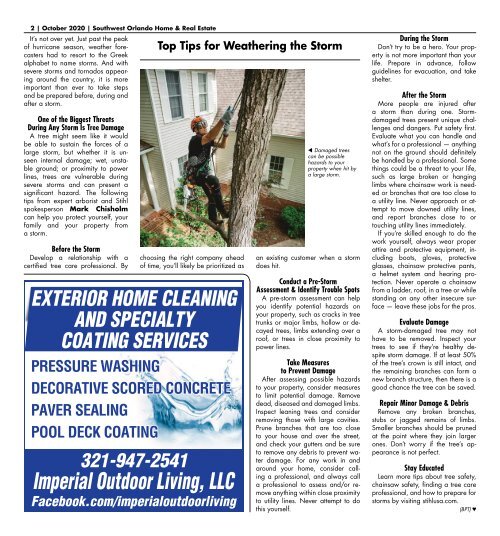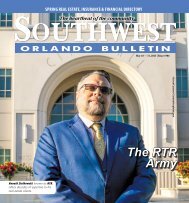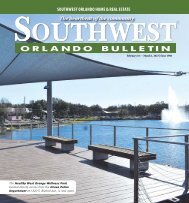Create successful ePaper yourself
Turn your PDF publications into a flip-book with our unique Google optimized e-Paper software.
2 | October 2020 | Southwest Orlando Home & Real Estate<br />
It’s not over yet. Just past the peak<br />
of hurricane season, weather forecasters<br />
had to resort to the Greek<br />
alphabet to name storms. And with<br />
severe storms and tornados appearing<br />
around the country, it is more<br />
important than ever to take steps<br />
and be prepared before, during and<br />
after a storm.<br />
One of the Biggest Threats<br />
During Any Storm Is Tree Damage<br />
A tree might seem like it would<br />
be able to sustain the forces of a<br />
large storm, but whether it is unseen<br />
internal damage; wet, unstable<br />
ground; or proximity to power<br />
lines, trees are vulnerable during<br />
severe storms and can present a<br />
significant hazard. The following<br />
tips from expert arborist and Stihl<br />
spokesperson Mark Chisholm<br />
can help you protect yourself, your<br />
family and your property from<br />
a storm.<br />
Before the Storm<br />
Develop a relationship with a<br />
certified tree care professional. By<br />
choosing the right company ahead<br />
of time, you’ll likely be prioritized as<br />
EXTERIOR HOME CLEANING<br />
AND SPECIALTY<br />
COATING SERVICES<br />
PRESSURE WASHING<br />
DECORATIVE SCORED CONCRETE<br />
PAVER SEALING<br />
POOL DECK COATING<br />
321-947-2541<br />
Imperial Outdoor Living, LLC<br />
Facebook.com/imperialoutdoorliving<br />
Top Tips for Weathering the Storm<br />
Damaged trees<br />
can be possible<br />
hazards to your<br />
property when hit by<br />
a large storm.<br />
an existing customer when a storm<br />
does hit.<br />
Conduct a Pre-Storm<br />
Assessment & Identify Trouble Spots<br />
A pre-storm assessment can help<br />
you identify potential hazards on<br />
your property, such as cracks in tree<br />
trunks or major limbs, hollow or decayed<br />
trees, limbs extending over a<br />
roof, or trees in close proximity to<br />
power lines.<br />
Take Measures<br />
to Prevent Damage<br />
After assessing possible hazards<br />
to your property, consider measures<br />
to limit potential damage. Remove<br />
dead, diseased and damaged limbs.<br />
Inspect leaning trees and consider<br />
removing those with large cavities.<br />
Prune branches that are too close<br />
to your house and over the street,<br />
and check your gutters and be sure<br />
to remove any debris to prevent water<br />
damage. For any work in and<br />
around your home, consider calling<br />
a professional, and always call<br />
a professional to assess and/or remove<br />
anything within close proximity<br />
to utility lines. Never attempt to do<br />
this yourself.<br />
During the Storm<br />
Don’t try to be a hero. Your property<br />
is not more important than your<br />
life. Prepare in advance, follow<br />
guidelines for evacuation, and take<br />
shelter.<br />
After the Storm<br />
More people are injured after<br />
a storm than during one. Stormdamaged<br />
trees present unique challenges<br />
and dangers. Put safety first.<br />
Evaluate what you can handle and<br />
what’s for a professional — anything<br />
not on the ground should definitely<br />
be handled by a professional. Some<br />
things could be a threat to your life,<br />
such as large broken or hanging<br />
limbs where chainsaw work is needed<br />
or branches that are too close to<br />
a utility line. Never approach or attempt<br />
to move downed utility lines,<br />
and report branches close to or<br />
touching utility lines immediately.<br />
If you’re skilled enough to do the<br />
work yourself, always wear proper<br />
attire and protective equipment, including<br />
boots, gloves, protective<br />
glasses, chainsaw protective pants,<br />
a helmet system and hearing protection.<br />
Never operate a chainsaw<br />
from a ladder, roof, in a tree or while<br />
standing on any other insecure surface<br />
— leave these jobs for the pros.<br />
Evaluate Damage<br />
A storm-damaged tree may not<br />
have to be removed. Inspect your<br />
trees to see if they’re healthy despite<br />
storm damage. If at least 50%<br />
of the tree’s crown is still intact, and<br />
the remaining branches can form a<br />
new branch structure, then there is a<br />
good chance the tree can be saved.<br />
Repair Minor Damage & Debris<br />
Remove any broken branches,<br />
stubs or jagged remains of limbs.<br />
Smaller branches should be pruned<br />
at the point where they join larger<br />
ones. Don’t worry if the tree’s appearance<br />
is not perfect.<br />
Stay Educated<br />
Learn more tips about tree safety,<br />
chainsaw safety, finding a tree care<br />
professional, and how to prepare for<br />
storms by visiting stihlusa.com.<br />
(BPT) ª

















